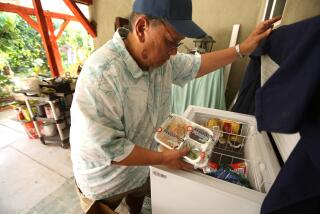Is Topanga Ready for Soup Lines? : Poverty: After a yearlong crackdown on the homeless in the area, one group is trying to help by providing food and other services.
- Share via
It was morning in Topanga Canyon. Fog lifted from the mountains as steam rose from a large pot of chili. Several dozen day laborers stood in line, waiting for a free breakfast of hot soup, bread and fruit.
Suddenly, the quiet scene was interrupted by shouts from a passing truck. The driver’s words weren’t entirely clear--something about “them”--but his tone obviously was one of anger. Volunteers Marg Starbuck and Susan Lovell looked at each other, shook their heads and kept passing out the food.
“If we wait for government to take care of them, we’ll wait forever,” said Lovell, a movement therapist who has lived in the canyon on and off since 1965. Lovell recently joined a group known as PATCH--People Assisting Topanga Canyon’s Homeless--which was formed several months ago to help day laborers and any other local homeless people.
As the presence of day laborers persists in Topanga Canyon, the approximately 9,000 residents remain divided on whether to embrace, shun or simply tolerate them. In recent weeks, however, after a year of stepped-up sheriff’s patrols and immigration raids that defied the community’s bohemian reputation, Topanga seems to have shifted back to its liberal roots.
One group of volunteers cooks and serves soup every weekday morning. Another holds English classes. Still another is hoping to establish a hiring center.
Most are working under the auspices of PATCH. Members said they formed PATCH in response to suggestions that residents boycott day laborers and turn them in to authorities.
“All of us feel very strongly that these people are a part of our community,” said Maryana Kuretski, a family therapist. “We are using them. There are a lot of jobs up here, mainly in construction, and it is our obligation to integrate them.”
For journalist Flavia Potenza, who moved to Topanga 15 years ago from New York City, the day laborer debate also signifies the canyon’s gentrification as property values increase and a more conventional crowd moves in.
“People just don’t yell at you about your dogs anymore. They sue you,” Potenza said. “The funkiness of the canyon has gotten cleaned up.”
For the last six weeks or so, every weekday morning, as many as 50 men have gathered near the corner of Topanga Canyon and Old Topanga Canyon roads for the homemade soup. Starbuck, an artist, picks up groceries donated by Topanga and Santa Monica markets and passes them out to a network of cooks, who take turns serving their creations from the backs of the trucks and vans.
The food is served between 9:15 and 9:30 on the theory that those who have gotten work for the day have already been picked up.
On a recent morning, the laborers eating breakfast said Topanga Canyon is popular among them because of generous wages--$5 or $6 an hour compared with an average of $4 an hour elsewhere in the city--in addition to its friendly residents and, now, its soup kitchen.
“For me, it’s real helpful and demonstrates that the American people--as I’ve always believed and been told--are very humanitarian,” said farmer Thomas Carnales, 42, who said he left El Salvador after his 16-year-old son was killed by guerrillas.
Some canyon homeowners remain concerned about day laborers camping in drought-stricken hills and now fear that PATCH may inadvertently contribute to the risk of fire.
“What I fear is that it’s going to encourage them to live in the brush in Topanga,” said filmmaker David Gottlieb, a Topanga-Las Virgenes Resource Conservation District board member who specializes in fire prevention.
More to Read
Sign up for Essential California
The most important California stories and recommendations in your inbox every morning.
You may occasionally receive promotional content from the Los Angeles Times.













